Text
The Kirakh (REVAMPED)

Introduction
The Kirakh were a 13 ft tall reptilian alien sophont race hailing from the Xyke System, a star system similar to ours in the Andromeda Galaxy, orbiting around a K-type variable star. They are currently a type 2 civilization on the Kardeshev scale, having colonized two other star systems in their stellar neighborhood, and is working on another one. Their empire consists of the Xyke system, where they come from, and has six planets, the Yyhakhe system, a nearby star system with eight planets orbiting around another K-type orange dwarf, The Raxycha system, a star system with ten planets around an M-type red dwarf, and the Tyxoo system, which is a binary star system with two M-type red dwarfs and twelve planets.
The species is currently recovering from a devastating world war that temporarily crippled their planet way before they decide to venture to the cosmos, about 100 years ago, approximately. They also have a long history in relative to their star's long lifespan.
The Kirakh evolved from tree-dwelling omnivores that fill in the niche of a squirrel/monkey from a rainforest in whats now the Great Zoghese Desert.
(huge wall of text warning)
Species
The Kirakh are divided into two species, the Northern Temperate which originate from the Natikan continents of Talyke and Sanland, and the ones that originate from the rest of the world. The Northern Temperate Kirakh are classified by their unique ability to antifreeze during the long, sunless winters.
Anatomy
Physical Appearance
The Kirakh have a total of three pairs of limbs, with the midlimbs and the rearlimbs being functioned for walking, while the remaining forelimbs being used to manipulate objects and items.
Unlike humans, which have pentadactyly digits, Kirakh have tridactyly digits, meaning they posess three fingers on each limb. The digits on the midlimbs and the rearlimbs have been arranged in a chameleon-like form, with two digits in the front and one in the back, and reverse in the rearlimbs.
Their forelimbs have evolved to become three-fingered hands with opposable thumbs that allows them to manipulate and interact with the world around them, as well as retractable "hooks" in their digits that is once used to hook onto the surface of the trees and help be better at climbing.
It appears that the rearlimbs on the Kirakh are facing backwards unlike the other two frontal limbs. Of course, this is a universal trait for some backboned creatures on the planet, which they take from their ancestors millions of years ago.
The Kirakh also have gold patterns that range in opacity and varies from individual to individual, that they oftentimes use to tell each other apart. There are actually hundreds of gold pattern variations.
The Kirakh mostly exhibit some sexual dimorphism, with males being more likely to have wider eyes, bigger cheek horns, a more larger more flashier crest, and a more wider gold pattern variety, but being smaller than females, while females are more likely to have narrow eyes, smaller cheek horns, smaller crests, and a more limited gold pattern variety and are more bigger than males.
Some parts of the Kirakh skin, such as the face and the limbs, are made out of the same leather human skin is made out of, with a layer of keratin scales going down from the nape to the section where the tail meets the body. The Kirakh also have feathers under that layer of scales that cover most of the body, usually shorter and more rougher when in warmer regions to and longer and fluffier in colder regions to preserve body heat.

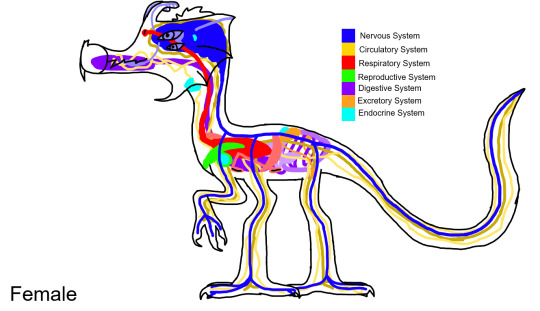
Nervous System and Senses
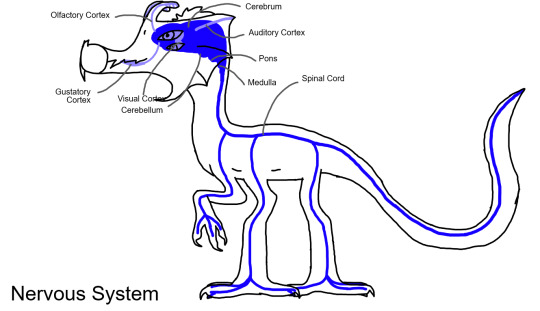
The Kirakh have developed a large brain for complex problem-solving abilities and had evolved to be the sophont species of their planet. The central nervous systems consists of the following:
The cerebrum - Most of the basic functions like consciousness, speech recognition, etc.
The cerebellum - Movement co-ordination
The Pons and Medulla - Basic vital functions eg breathing
Their senses - Like the Olfactory Cortex (smell), the Auditory Cortex (hearing), the Visual Cortex (sight), and the Gustatory Cortex (taste)
Kirakh eyes function similarly to human eyes in that they are composed of a lens and retina. But, while humans have three color cone cells, Kirakh have four, and they can detect colors from anywhere to reds, greens, blues, and far into the ultraviolet range, which means their vision can be equivalent to Earth bird vision.
For example, the hard skin of some common temperate Natikan fruit would be dull colored according to human vision, while it would be a bright ultraviolet color according to Kirakh vision. Generally, certain colors might mean certain things for the Kirakh, a delicious fruit would range from bright colors like ultraviolets to blues to greens according to the Kirakh, while a red or dull color might signal them to stay away or don't eat.
Kirakh smell with their antennae, which were the long-to-short appendages on their forehead. These antennae were external olfactory bulbs, which at the tip can open to show sensory cilia, which can detect scent particles, and can retreat back into the antennae when not in use.
One thing is to be noted is that the Kirakh can smell things that humans can't smell, for example, the smell of sand, or the smell of tasty fruit (wait can humans smell fruit??).
Their earholes are actually in the giant crests that the Kirakh use to express themselves, there is one pair of earholes on the top crest though, the two others are only for show. The Kirakh can only hear in ranges of 0 decibels to only 100 decibels. For example, the Kirakh may think that human music is too "deafening" or "loud" and can temporarily make them deaf for some minutes, which is why they favor more slower, more calmer music.
Circulatory and Respiratory System
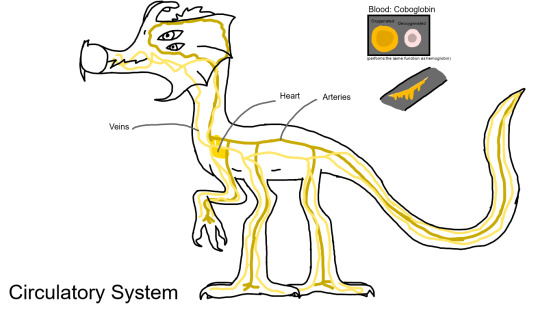
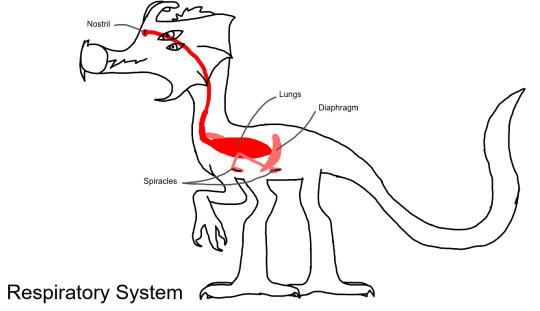
Kirakh blood is made up of coboglobin, which replaces the iron atoms with cobalt atoms, and it performs the same function as the hemoglobin found in humans. It makes their blood amber yellow in the arteries and clear in the veins.
Every 24 Earth hours, the molecule would have worn itself out, and it would change from it's usual amber yellow color to a deep pink. Thankfully, the Immune System would send special cells to take care of the problem, although there are some instances when the Kirakh gets older and their immune system becomes too weak to send these special cells to pick up dead blood cells. This might be indicated by their unusual deep pink blood color.
They would need double the oxygen intake because of that, so they have three pairs of breathing holes, the first pair is located on the forehead, in front of the antennae, while the remaining two pairs are located along the sides of their body. The first pair is also useful for when the individual is swimming and the four spiracles on the body close, to avoid water getting in the lungs, but it also needs to breathe too, so they would have one extra breathing hole on their head.
Digestive and Excretory systems

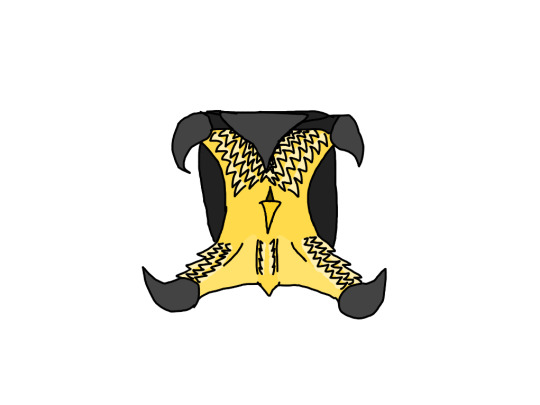
The Kirakh mouth consists of five "teeth" on their jaws, which is used to break through the hard skin of certain fruits (The skin is also somewhat edible for them). And in the maw there are a bunch of tiny teeth for chewing food. Their bottom jaws are split into three sections, once used to net insects into their mouth. They can move each section individually.
I forgot to put this on the mouth image, but there is a choana on the roof the roof of the mouth that connects to the nasal passageway.
They also digest and eat food similarly to humans, but with a crop organ that can store food for digesting later. Eaten food will wait about 3 hours before moving to the stomach to be digested. However, in females, the crop can be used to produce crop milk, which they use to feed their young.
Endocrine and Reproductive Systems
!! warning: mention of genitals and kinda detailed !!
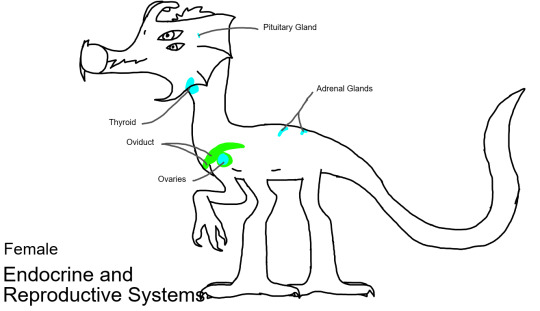

The Kirakh have a pituitary gland, the master gland, that can secrete hormones that can control growth, blood pressure, and many others. I didn't list it in the diagrams, but they also have a pineal gland in the brain that can secrete melatonin and regulate their sleep cycle, which will be explained later.
They also have a thyroid gland in their throat, which is necessary for controlling their metabolism, the rate at which the food is used. They have a pair of adrenal glands on the top of their kidneys which can secrete the hormone adrenaline when in times of crisis or hard exercise, much like humans.
What's not much like humans is how they reproduce. While human egg cells are fertilized internally, Kirakh egg cells are fertilized externally. This is because the reproductive organs are located in the chest cavity, and it might be hard for the young to develop internally inside the mother.
Females produce ovum, or unfertilized eggs, once they hit sexual maturity (which is the age of 15), and they might wait inside the oviduct until use. Males have a hemipenes, which is inverted, and they can evert for fertilization. They produce millions of fly-sized flying gametes with genetic information stored inside. The Kirakh egg is spherical, with a round capsule on the top, which is open before being fertilized, and once it is it will start forming a hard material around the capsule, which will keep the developing young inside safe. Gestation period will last 6 Natikah months before hatching into a young kirakh. Below is a kirakh egg.

As mentioned before, female Kirakh can use their crop organ to produce crop milk to feed their young. This can be seen in some Earth birds, like pigeons, doves, and other birds.
Behavior
Thermoregulation and Circadian rhythm
Being cold-blooded creatures, The Kirakh are sun-loving and are strictly diurnal, being active in the day where sunlight is plentiful. Kirakh may bask two times a day, one in the morning when they just woke up and may not have any energy in them, and one during the afternoon, when the sun is high up. Then they will go to sleep when the sun starts sinking below the horizon.
However, in the Northern Temperate area of the planet, it will be always day during the summer and it will always be night during the winter, and during the winter, the Northern Kirakh have a specialized anti-freeze stimuli that activates, sending them to a deep sleep that lasts till the sun starts appearing in the sky. This special stimuli is not in the rest of the world though, because there is always periods of sun all-year long.
Family Structure
Most cultures and ethnicities of the Kirakh practice polygamy, where one individual might take up multiple mates at the same time, usually about 2-6 mates per usual. They would eventually make extended tight-knit family groups, called yikha in their dominant language, which is made up of the leader's mates, their children, and their children's mates and grandchildren, and so on, and sometimes, the leader's or mate's siblings would be included in the picture.
One problem is that it sometimes gets a little bit too overcrowded, which is why Kirakh sometimes kick one of their yikha members out, either to live with another yikha, or to start their own yikha. There were polygynous families, where the female is usually the dominant leader, and the more rarer polyandrous families, where the male is usually the leader. I might describe the yikhas in depth in a future post.
Growth Cycle
Juvenile
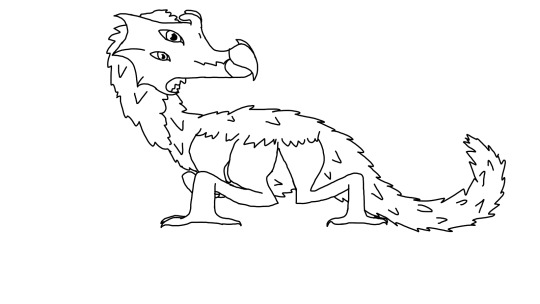
The average Kirakh would live from around 90-150 years
The Kirakh start off as hairless, have improper antennae, have wide, sprawled out legs, and feeding off of their mother's crop. They will later grow a coat of fluffy, downy hair, and will learn how to walk or crawl for a little bit a month after being born, but they will still feed on crop milk periodically. Eventually, when they are a year old they would have stood up for a bit and have been weaned, and they are considered to be good at doing most things on their own. Juvenile Kirakh would most of the time get an education at age 3.
Their metabolism rate is also high at the juvenile stage which means their thyroid gland enlarged, and will get smaller the more older they get, and their legs get more erect the older they get.
Adolescent/Adult

Once they hit a certain age, from around 14-15 years old, their downy hair will fall off to make way for feathers, and a large space on the spine for the keratin scales to grow, which will take 6 years, and by that time when they are 21 years old. They will also hit sexual maturity at age 15, but they are considered to be fully mature when they are 21 years old, meaning that they can do anything on their own without a parent.
Kirakh would start getting old from around 70-75 years old, which means they will have a slower metabolism, chipped scales, paler feathers, and a weaker immune system.
2 notes
·
View notes
Text
Introduction to my project
I didn't make an introduction to draw people in, so here!
The Kirakh Project is a scifi fantasy that takes place in the Andromeda Galaxy, and it currently surrounds around the titular species, the Kirakh, hence the name. I would first explain said species' anatomy, how they work, their ethnicities, their cultures, and some other details, while also explaining the planet they live on, called Natikah, and some other planets in their solar system, and some other solar systems that the Kirakh have colonized. Then I will explain the species' history, some significant events that happened during this history, from stone tools to intergalactic colonies on other planets.
And, once I felt that this was all done, I would then explain the anatomy, the cultures, the history, and some other things of the other spacefaring species of the Andromeda Galaxy, about 7 in total, including the Kirakh.
And once this is all in full circle, I would then explain the contemporary events, and how each species found each other, and this might end during when the Andromeda and Milky Way would collide with each other, where the species might eventually find the humans.
I might also set up an rp site, who knows?
Right now, this would only focus on the Kirakh, which is why this project is called The Kirakh Project.
(sorry if my grammar seems a little broken)
Index
The Kirakh
#worldbuilding#speculative biology#spec bio#alien species#sci fi#sci fi and fantasy#speculative zoology
0 notes
Text
Animals of Natikah
Reptilians







Some creatures, with their name in the Sanatakea language in the top, and their scientific name in the bottom, in a made up conlang that I quickly made for this.
List of creatures and the niches they were supposed to represent:
Laarecou: Fast running grazer (antelope, deer, or kangaroo analogy)
Renoulis: Lithe pursuit predator (wolf analogy)
Sazukaa: Supposed to be a sheep/goat analogy
Kouki: Small stocky carnivore (badger or wolverine analogy)
Zouxuyee: Armored herbivore (Rhino or cattle analogy)
Rehou: Giant browser (Giraffe analogy)
Zeyaaxu: Medium browser (Moose analogy)
Saakee: Small grazer (Rabbit analogy)
Leara: Supposed to be a mouse/rat analogy
Sanre: Arboreal predator
Keaxe: Arboreal omnivore (Monkey/squirrel analogy, closely related to the Kirakh)
Naaxi: Large omnivore (supposed to be a pig analogy, design might change later)
Neexou: Specialized insectivore (Anteater analogy)
Pentapodia: Bulky ambush predator (Large cat analogy)
Thanea: Bulky ambush predator (Bear analogy)
Sikhukhaa: Giant browser (Elephant analogy)
Mammals

There's only two of these right now, there might be more in the future.
Seakeli: Lizard analogy
Xanouthi: Kinda lizard analogy, but it is erect.
These are currently the only animal groups that I have, I would make more if I could.
0 notes
Text
Natikah



Introduction to Natikah
The first image is a geographical map of the planet's landmasses and structures. Please keep in note that this is an old and outdated version of the map and some of the names aren't official, and some of the mountains aren't on the climate maps or vice versa. This is only to tell you some of the continent names.
The last two images are the climate maps, with the last one being without the current lines
Natikah is the second planet from it's sun and is slightly larger and different than Earth. They both have prograde orbits, but Natikah has a axial tilt of 39 degrees, which means that it will be always be day during the summer, and it will always be night during the winter in northern temperate and polar continents like Sanland or Talyke. I'm not sure about the southern continents though, I gotta run the simulation again some time.
Natikah also has two moons, called Zixarin and Altas, which slow down the planet's rotational period to 30 Earth hours a day. The two have been believed to be formed by a catastrophic collision between Natikah and a protoplanet billions of years ago during it's formation, similar to the Theia Hypothesis.
Zixarin is the more closer and prominent moon to the planet. During certain periods of time, and because of the planet's slightly eccentric axial tilt, Zixarin would appear in the sky during the day, and would even "eclipse" the sun. Altas, however, is more further from the planet. In reality though, Zixarin and Altas are like slightly the same size as each other, with Zixarin being slightly larger than Altas.
As I've mentioned before, Natikah is the second most planet from it's star in the Xyke System, which orbits around a K4 variable star, which means that Natikah's sun is more cooler and more orange than our sun. Natikah has a slightly more faster orbital period around it's sun than ours, one Natikah year more shorter, around 255.688 Earth days.
Biosphere and Atmosphere makeup
Natikah is more warmer and has more oxygen in the atmosphere, to better accommodate with the animals which have cobalt-carrying blood. It is also noted that the plants on here are carriers of the pigment Phycoethryn, which makes the leaves on the plants a brownish-red color.
Here is a sneak peak into the biosphere of the planet:

In the tropical savannas of Zogha, a herd of animals filling in the fast-running grazer niche (haven't decided a name for them yet) grazes in the tall grass in the dry season.
I'm sorry if I only have one image though. It takes a lot of time and effort to draw detailed environment shots. :(
2 notes
·
View notes
Text
The Kirakh
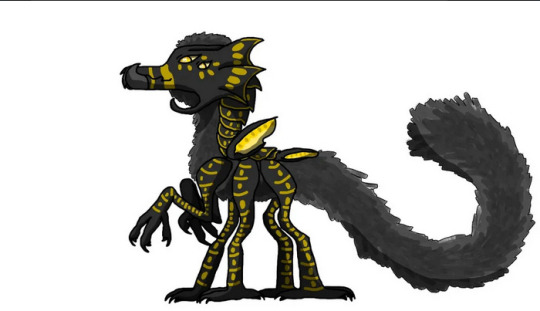
The Kirakh
Introduction
The Kirakh were a 13 ft tall quadrupedal alien species hailing from the Xyke System, a planetary star sytem orbiting around a K-type variable orange dwarf star. They are a type 2 civilization on the Kardashev scale, as they have colonized their entire star system and two other neighboring systems, and is currently working in on a third.
The species is currently recovering from a devastating world war on their home planet that had crippled their civilization temporarily about 100 years ago, but now, they have advanced in technology afterwards and had journeyed to the cosmos ever since. They also have a long history in relative to their star's long lifespan.
The Kirakh base their calendar system around a supervolcanic eruption event from around 200,000 years ago (these approximations may change when I start charting their history), during when the species is in their stone age period.
B.E - before eruption
D.E - during eruption
A.E - after eruption
I like to think that the species is located somewhere in the Andromeda Galaxy, and that the Kirakh were the closest thing to us humans in that galaxy. After all, no two alien races are the exact same, as I like to believe.
Anatomy
Chemistry
The Kirakh are carbon-based lifeforms like us, but they do also have some things that differentiate them from us too.
Unlike humans, the Kirakh have cobalt in their blood instead of iron, these proteins are called coboglobin. They function the same as the hemoglobin found in humans, and it makes their blood amber-yellow in the arteries, and clear-colored in the veins.
Limbs
Guys just ignore the small wings on their back, the image is just one of their earlier versions and they were originally gonna have these wings, but now I will be retconning them to don't have these wings.
The Kirakh have a total of three pairs of limbs, with the midlimbs and the rearlimbs being functioned for walking, while the remaining forelimbs being used to manipulate objects and items.
Unlike humans, which have pentadactyly digits, Kirakh have tridactyly digits, meaning they posess three fingers on each limb. The digits on the midlimbs and the rearlimbs have been arranged in a chameleon-like form, with two digits in the front and one in the back, and reverse in the rearlimbs.
Their forelimbs have evolved to become three-fingered hands with opposable thumbs that allows them to manipulate and interact with the world around them, as well as retractable "hooks" in their digits that is once used to hook onto the surface of the trees and help be better at climbing.
It appears that the rearlimbs on the Kirakh are facing backwards unlike the other two frontal limbs. Of course, this is a universal trait for some backboned creatures on the planet, which they take from their ancestors millions of years ago.
Skin and fur
Some parts of the Kirakh skin, such as the face and the limbs, are made out of the same leather human skin is made out of, with a layer of keratin scales going down from the nape to the section where the tail meets the body. The Kirakh also have fur under that layer of scales that cover most of the body, usually shorter and more rougher when in warmer regions to and longer and fluffier in colder regions to preserve body heat.
Respiratory System
The Kirakh have spiracles on their chest region, altough they are hidden in the fur. In some ethnicities born in warmer regions of the planet, where fur is more shorter, there is a bare patch on each of the spiracles. The spiracles connect to the lungs of the individual and is used to absorb oxygen and to distribute it along the bloodstream. Like us humans, Kirakh need oxygen to survive, and also need constant oxygen while exersizing. Kirakh lungs are also quite large to handle the strain of climbing trees.
Reproduction
The Kirakh use the basic two-gender system that most organisms on theirs and our planet use. They practice external fertilization, mainly because their reproductive parts are located in their chest cavity region, so it might be impossible for offspring to develop inside.
The female produces ovum, or unfertilized eggs, while the male produces fly-sized winged gametes that crawl into the open capsule into the ovum, and then fertilizes the egg cell inside, eventually resulting with a fertilized egg, that within around 6 months, will hatch out a young kirakh.
Life Cycle
Juvenile
The average Kirakh lives from around 90-150 years. They start off as tiny and hairless, and feeding off their mother's crop, and over time, they start growing a coat of fluffy fur that wards off parasites and other pesky insects and unwanted guests from entering it's body, and it also keeps them at their core body temperature.
They also have a fast metabolism rate when young, as they need lots of food to grow and stay energized. Kirakh young also have a sprawled stance, but then their legs get more erect as they grow.
Frequently during their juvenile stage, Kirakh shed their old coat of fur and be replaced with a new one once in every year, in a process called molting. This is usually because their fur doesn't grow along with it.
Adolescent/Adult
When the Kirakh get into a certain age, which is about 14-15 years, the fur on their back will start to fall off to make way for the keratin scales that will grow eventually. The adolescent stage will eventually end 6 years later, when they are 21 years old, their scales would be fully grown and the growth cycle would be complete as it enters the adult stage.
Kirakh may also become old when they are around 70-75 years old.
1 note
·
View note